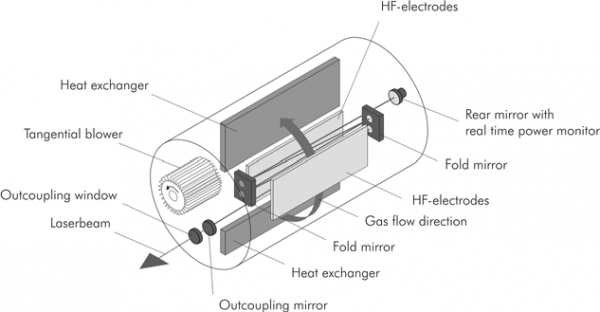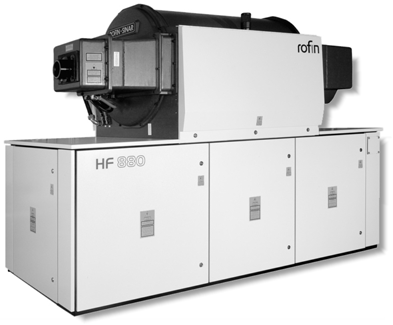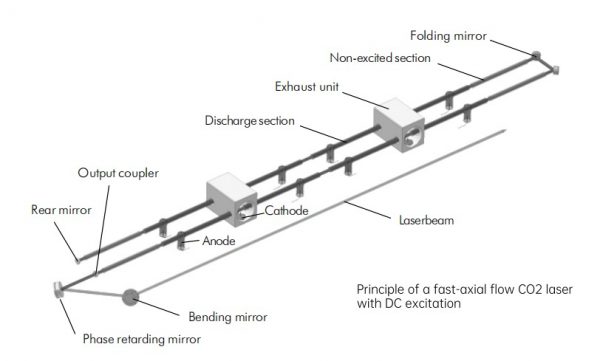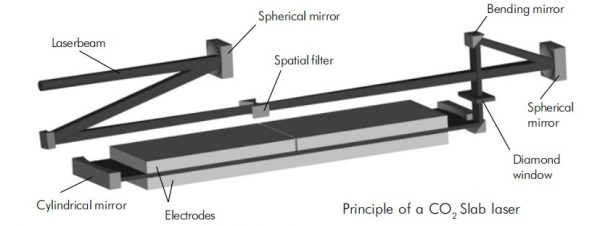An introduction to CO2 Laser
CO2 lasers typically emit light with a wavelength of 10.6 µm and possess overall efficiencies of approx. 10 to 13 %. CO2 lasers always utilize a gas mixture to generate the laser beam. This laser gas mixture invariably consists of helium, nitrogen, CO2 and possibly other additives. The laser-active medium, CO2 gas, is stimulated by electrical gas discharge. During this process, the nitrogen molecules transfer energy from electron impact to the CO2 molecules. The transition from energetically excited CO2 molecules (upper vibrational level) to a lower energy level (lower vibrational level) is accompanied by photon release, ultimately leading to emission of a laser beam. By colliding with the helium atoms, which comprise the major share of the gas mixture, the CO2 molecules return to the ground state and are now available for another cycle. Basically, low pressure (typically 100 – 250 hPa) is needed to allow these events to proceed in the laser gas. The excess energy that cannot be used to generate the laser beam must be removed from the system as heat. The pertinent technologies depend on the design of the laser instrument and are to be discussed in greater detail.
There are different types of laser design, characterized by continuous-flow or stationary gas mixtures. An important factor is the stimulation of the electrical gas discharge in the gas mixture (radio frequency or direct current stimulation).
In direct-current stimulated lasers, gas discharge between electrodes allows the electrical energy to be directly coupled into the laser gas. Direct-current stimulated CO2 lasers may be produced inexpensively and attain the comparatively highest overall efficiency, which still makes them a financially feasible alternative for a variety of machining purposes.
Radio frequency stimulated lasers (RF lasers) are characterized by capacitive incoupling of the electrical energy needed for gas discharge (no anode or cathode inside the gas mixture). In modern lasers, the RF discharge is oriented perpendicularly to the resonator axis. By modulation of the RF power, RF-stimulated CO2 lasers may be adjusted between additional power limits and are pulsable at high repetition rates. Lower overall efficiencies attained by radio frequency stimulated lasers are accepted especially for laser powers (> 2 kW) where electrode consumption in direct-current stimulated lasers would necessitate increased service efforts.
Conventional radio frequency generators consist of an oscillator generating the radio frequency as well as an RF amplifier tube enhancing it. Modern generators, as developed and manufactured by ROFIN, are constructed as ”self-oscillators“ and consist only of an RF amplifier tube and have a comparatively simple design. Due to their constructional principle, they have a higher availability than oscillator/amplifier RF generators. They are almost service-free and in particular, attain higher excitation efficiency factors, thus reducing laser-operating costs.
Another primary aspect in conjunction with high-power CO2 lasers is the fact that a sufficient amount of stimulated mode volume must be available to generate a beam power of typically more than 500 watts. The beam paths between the end mirror and the output coupler mirror are folded in order to achieve maximum use of the available space without building excessively large or long lasers; i.e., the beam is repeatedly deviated via mirrors in order to make better use of the available space. Folds may be either rectangular or triangular, also allowing direct laser polarization. If possible, the number of mirrors in the resonator should be minimized in order to simplify the construction and reduce service costs.
The different resonator design types are classified in accordance to the ray trajectory. If the laser light can only exit the resonator chamber through a partially transmitting mirror, we have an optically stable resonator. A resonator consisting of highly reflective mirrors arranged so the laser light can be outcoupled past one of the mirrors is referred to as an optically unstable resonator. Lasers in the maximumpower range with small beam diameters do not necessarily benefit from stable resonators. This is due to the critical thermal stability of the transmitting output coupler mirror. Unstable resonators may be suited for these purposes. In addition, unstable resonators allow good adaptation of the resonator chamber to the geometry of the stimulated laser-active medium.
Generally, the following principle applies to all CO2 lasers: The larger the beam diameter, the lesser the load on the optical systems, which in turn, enhances the durability of the system.
CO2 lasers utilize exactly one of the lasing transitions of the CO2 molecule, principally at a wavelength of 10.6 µm. However, by applying different mirror coatings in the resonator of a CO2 laser, other lasing transitions may also be used, giving rise to wavelengths of 9.6/9.3 or 11.4 µm, respectively. These alternative wavelengths, however, play a minor role and are only used occasionally, for instance to drill printed circuit boards.
Cross-flow CO2 lasers
CO2 lasers with a laser gas flow oriented rectangular to the resonator axis are referred to as cross-flow lasers. With this design type, a relatively slow gas flow – generated by a tangential blower located inside the laser chamber removes the heat from the large-volume discharge chamber. During its rotary movement, the laser gas passes through large-area heat exchangers with cooling water. In addition, the gas is also transported through the area of capacitive energy incoupling between the electrodes. The entire chamber, including the blower, the electrodes and the heat exchanger are evacuated. The laser power can be generated in a multi-folded resonator between two folding mirrors only. This makes it possible to inexpensively manufacture compact high-power lasers whose beam power and beam quality (multimode, K ≥ 0.18) are ideally suited for most welding applications, where larger gaps have to be bridged.

Apart from their favorable properties for laser welding applications, cross-flow CO2 lasers (ROFIN 840 to 880 HF) offer the following benefits:
- This type of laser uses a wear-resistant, semiconductor switching power pack instead of an RF tube.
- No quartz glass is used for the laser gas circulation system, which normally needs to be exchanged after an operating time of 8,000 to 10,000 hours.
- The laser is integrated into the control cabinet, allowing compact, simple construction.
- Operating costs are very low compared to axial-flow lasers with the same laser power, due to low energy and gas consumption.
- The simple construction of this type of laser (with only few wearing parts as well as low speeds for the used tangential blowers) guarantees high laser availability in automated production lines.

Fast-axial flow CO2 lasers
Since 20 years, fast-axial flow, high-power CO2 lasers have been used for cutting and welding applications in industry. Due to their physical principle, these lasers provide a better beam quality than cross-flow lasers and offer a rotation symmetrical power distribution in the raw beam up to 20 kW output power. The principle shown in Figure is based on a robust single U-folded resonator consisting of two folding mirrors, a rear mirror and an output coupler. The laser beam is generated by 8 active discharge sections, powered by industrially-proven DC excitation. A λ/4 phase retarding mirror, which is integrated into the resonator, generates a circularly polarized output beam. Two side-channel blowers take care of a high-speed circulation of the laser gas within the resonator.

Fast axial-flow CO2 lasers may be realized with a beam power ranging from a few hundred watts to more than 20 kW.
Diffusion-cooled CO2 lasers
In the very first CO2 lasers, the laser gas mixture, sealed inside a discharge tube, was cooled exclusively by heat conduction. Despite efficient cooling of the outer tube wall of the gas-transporting quartz glass, only about 50 W beam power per meter of tube length could be attained. In other words, this concept did not allow the construction of high-power lasers.
CO2 Slab lasers have a highly compact design, even compared to modern fast-flow lasers. These lasers are available in a power range between 1 and 6 kW and are equipped with large-area copper electrodes. Radio frequency gas discharge takes place between the electrodes (Fig. below). The narrow interelectrode spacing allows effective removal of the heat from the discharge chamber via the directly water-cooled electrodes. This gives rise to comparatively high power density. Heat transport is achieved exclusively by diffusion of the heated molecules to the cooled electrode plates; this principle is also referred to as a diffusion-cooled laser. The unstable resonator consists of rotation-parabolic mirrors, thus allowing the outcoupling of a laser beam with extremely good focusing properties. External,
water-cooled, reflective beam shaping components are used to make sure that the originally rectangular beam is converted to a rotation symmetrical beam with a beam quality of K ≥ 0.9.

The advantages of this technology may be summarized as follows:
- very compact and almost entirely wear-resistant construction
- high beam quality
- no gas cooler required
- low optical losses
- excellent thermal stability
- low gas consumption, no external gas cylinders required
- no gas flow and therefore no contamination of the resonator optics
- low maintenance.
